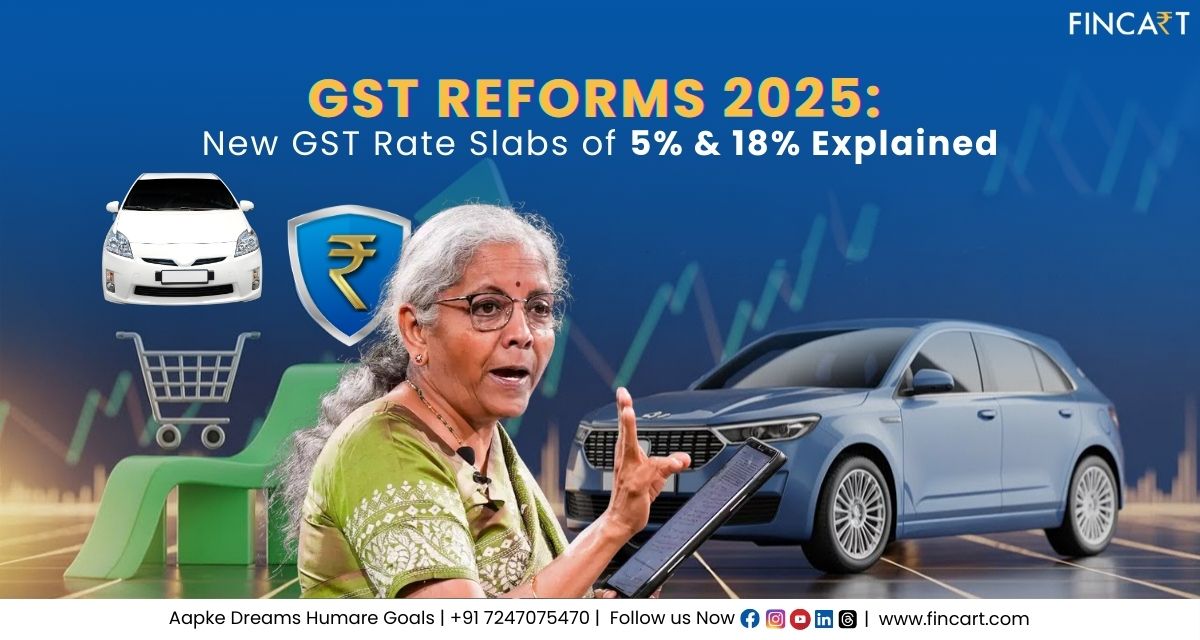The 56th GST Council meeting has brought one of the biggest tax reforms since the Goods and Services Tax (GST) was introduced in 2017. Finance Minister Nirmala Sitharaman announced a sweeping rationalisation of rates, reducing the existing four-slab structure (5%, 12%, 18%, 28%) into just two main slabs — 5% (Merit Rate) and 18% (Standard Rate) — along with a special 40% rate for luxury and sin goods.
This reform, effective from September 22, 2025 (the first day of Navratri), aims to simplify compliance, boost consumption, and bring relief to households and businesses alike.
In this article, we’ll cover everything you need to know — what’s cheaper, what’s exempt, the impact on different sectors, and answers to the most common queries.
Key Highlights of GST Reform 2025
Two-Tier GST Structure: Existing 4 slabs replaced by just 5% and 18%.
Special 40% Slab: For sin and luxury goods such as high-end SUVs, pan masala, tobacco, aerated beverages, yachts, and private aircraft.
Major Relief for Households: Toiletries, kitchenware, bicycles, packaged food, dairy, and plant-based milk see significant GST cuts.
Healthcare Benefits: Individual life and health insurance policies are now GST-free.
Boost to Housing: Cement and construction materials moved from 28% to 18%.
Clarity for Auto Sector: Uniform 18% GST on all auto parts, small cars, 3-wheelers, and motorcycles up to 350cc.
Support for Agriculture: Farm machinery, bio-pesticides, and irrigation equipment reduced to 5%.
GST Rate Changes – Before vs After
Here’s a detailed comparison of GST rates for major items:
| Category / Item | Old GST Rate | New GST Rate |
| UHT Milk, Paneer, Chapati, Roti, Paratha | 5% | Nil (0%) |
| Plant-Based Milk Drinks & Soya Milk Drinks | 12% / 18% | 5% |
| Hair Oil, Shampoo, Toothpaste, Soap, Toothbrushes | 18% | 5% |
| Butter, Ghee, Chocolates, Namkeens, Sauces, Instant Noodles | 12% / 18% | 5% |
| Baby Diapers, Napkins, Feeding Bottles | 12% | 5% |
| Air Conditioners, TVs (any size), Dishwashers, Monitors | 28% | 18% |
| Small Cars (≤ 1200cc petrol / ≤ 1500cc diesel) | 28% | 18% |
| Motorcycles ≤ 350 cc, 3-Wheelers, Goods Transport Vehicles | 28% | 18% |
| Mid & Large Cars, SUVs (≥ 1500cc, > 4000 mm length, ≥ 170 mm clearance) | 28% + Cess | 40% (No Cess) |
| Cement & Construction Materials | 28% | 18% |
| Life & Health Insurance (Individual) | 18% | Nil (0%) |
| Life-Saving Medicines (Cancer & Chronic Disease) | 5% / 12% | Nil (0%) |
| Medical Devices & Diagnostic Kits | 12% / 18% | 5% |
| Manmade Fibre & Yarn | 12% / 18% | 5% |
| Beauty & Wellness Services (Salons, Gyms, Yoga) | 18% | 5% (No ITC) |
| Auto Parts (All) | 28% | 18% |
| Agricultural Machinery, Tractors, Tractor Tyres | 12% / 18% | 5% |
Impact on the Common Man
This reform is a big win for households:
- Daily essentials like shampoo, soap, toothpaste, kitchenware, namkeens, and dairy products will now cost less.
- Plant-based milk and beverages have become more affordable at just 5% GST.
- Baby care essentials such as diapers, napkins, and feeding bottles now attract only 5% GST.
- Healthcare coverage becomes cheaper with zero GST on health and life insurance policies.
With prices falling across essential goods, households are likely to have higher disposable income — giving a direct boost to savings and consumption.
Impact on Real Estate & Infrastructure
Housing and infrastructure are likely to see cost reductions thanks to:
- Cement GST dropping from 28% to 18%.
- Lower GST on construction inputs.
This is expected to encourage new homebuyers and make projects more affordable for developers.
Impact on the Automobile Sector
The automobile sector gets a double benefit:
- Small cars, motorcycles, 3-wheelers, and goods transport vehicles now attract only 18% GST (down from 28%).
- Uniform 18% GST on all auto parts simplifies compliance and reduces disputes.
- Luxury cars and SUVs will now attract a 40% GST (no separate cess) — making them more expensive.
This could revive demand in the mass-market segment while maintaining higher taxation on luxury consumption.
Healthcare & Wellness Benefits
The government has made a strong push towards affordable healthcare:
- Nil GST on life-saving drugs and medicines used for chronic diseases.
- 5% GST on medical devices, diagnostic kits, and thermometers.
- No GST on individual health insurance policies, making medical coverage cheaper.
- Beauty, wellness, gyms, and yoga services will now attract just 5% GST (without ITC).
Sin Goods and Luxury Items – 40% Slab
Certain products will continue to attract a higher tax to discourage excessive consumption and boost revenue. These include:
- Luxury cars and SUVs (mid-size and above)
- Yachts, aircraft, and helicopters for personal use
- Pan masala, gutkha, chewing tobacco, unmanufactured tobacco
- Cigarettes and other tobacco products (taxed on retail price)
- Aerated drinks, carbonated beverages, energy drinks
This special 40% GST + cess structure will remain in place until compensation cess loans are fully repaid.
Impact on Businesses
Businesses stand to benefit from:
- Simplified compliance with just two GST slabs.
- Lower litigation due to clearer classification.
- Better input credit management thanks to rationalised rates.
- Expected increase in consumption leading to higher sales volumes.
Revenue Secretary Arvind Shrivastava confirmed that the reform is fiscally sustainable and is expected to improve compliance and overall tax buoyancy.
Effective Date
The new GST rates come into effect on September 22, 2025 (Navratri). There’s no need to cancel existing e-way bills for goods in transit — they remain valid as per their original validity period.
FAQs on New GST Rate Cuts 2025
1. What are the new GST slabs?
The GST Council has rationalised the tax structure into two main slabs – 5% (Merit Rate) and 18% (Standard Rate) – along with a 40% special rate for luxury and sin goods such as luxury cars, pan masala, tobacco, and aerated beverages.
2. When will the new GST rates be applicable?
The revised rates will be applicable from September 22, 2025 (Navratri).
3. What items are completely exempt from GST?
Essential food items like UHT milk, paneer, roti, chapati, paratha, maps, charts, exercise books, and certain life-saving medicines are completely GST-free. Individual health and life insurance policies are also fully exempt now.
4. What is the GST on plant-based milk drinks?
Plant-based and soya milk drinks will attract 5% GST.
5. What happens to tobacco products and pan masala?
Tobacco, pan masala, and gutkha will continue under the existing rate and compensation cess until all pending cess-related loans are cleared, after which they will move to a 40% slab on retail price.
6. Do I need to cancel e-way bills for goods in transit?
No. Existing e-way bills will remain valid until their original expiry date.
7. What is the GST on beauty and wellness services?
Salon, gym, yoga, and wellness services will now attract 5% GST (without ITC), making them more affordable.
8. Will my insurance premiums get cheaper?
Yes. With zero GST on all individual health and life insurance policies, your premiums will cost less.
9. Are food items like namkeen, ghee, and noodles cheaper now?
Yes. Their GST has dropped to 5%, which will make them more pocket-friendly.
10. How does this impact homebuyers?
With cement and construction materials taxed at 18% instead of 28%, the overall property construction cost is expected to reduce, making homes more affordable.
11. What is the GST rate for auto parts and vehicles?
All auto parts now attract a uniform 18% GST, while small cars, motorcycles (≤ 350 cc), and goods transport vehicles will now be taxed at 18% instead of 28%.
12. Will this reform simplify GST compliance for businesses?
Yes. The two-slab structure will make compliance easier, reduce disputes, and boost overall tax transparency.
Final Thoughts on New GST Rate
The GST rate cuts of 2025 mark a historic step towards a simpler, consumer-friendly tax regime. By reducing the cost of essentials, health coverage, and home-building materials, this reform aims to put more money in people’s hands and boost domestic demand.
For individuals and businesses, this is the perfect time to revisit financial plans, optimise tax-saving strategies, and invest the savings wisely.
At Fincart, we help you make the most of policy changes like this — ensuring your money works smarter for you.




